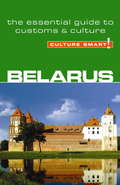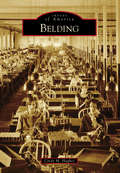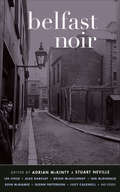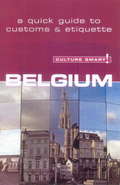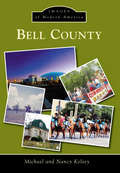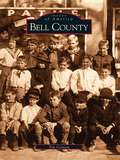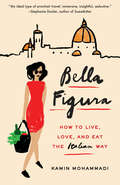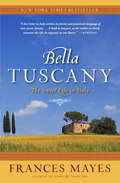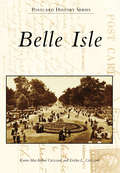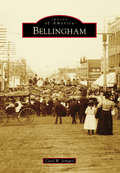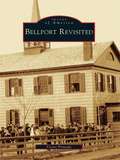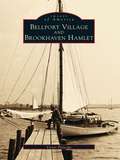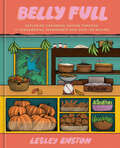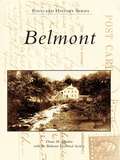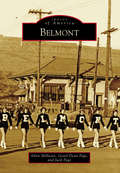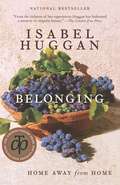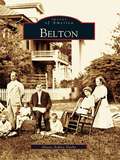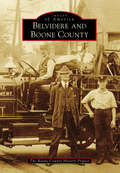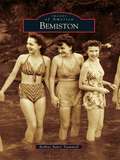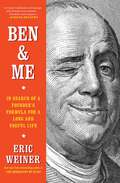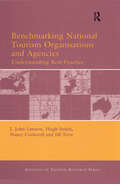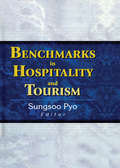- Table View
- List View
Belarus - Culture Smart!: The Essential Guide to Customs & Culture
by Anne CoombesDon't pack anxiety in your suitcase! By reading Culture Smart! Belarus before you go, will ease your travel, help you to make friends and avoid confusion. Culture Smart! Belarus will help you to understand Belarus manners, customs and laws. Culture Smart! Belarus goes the extra mile to help you brush up on your cultural small talk and will make you confident in leaving your comfort zone far behind. Walk hand in hand with a Culture Smart! guide and avoid misunderstandings that could cost you valuable time, money and enjoyment. . . With Culture Smart! Belarus you will learn about daily living, historical perspectives, taboos, business etiquette, eating and drinking and much more, allowing you to experience NAME like a native. Be responsible, be Culture Smart!
Belding (Images of America)
by Cindy M. HughesBelding is located in the northwest corner of Ionia County along the Flat River. The land was first settled by Charles Broas in 1837 and became known as Broas Rapids. The name was later changed to Patterson Mills, and in 1871 the small village was renamed Belding in honor of the Belding family. The Belding brothers manufactured silk and brought much activity to the community. Between 1885 and 1917, the Beldings operated four silk mills, two dormitories, Hotel Belding, a hospital, an opera house, a library, and many more downtown businesses. The silk mills alone employed more people than all other area factories combined. With the brothers controlling 90 percent of the American silk market, Belding became known as "Silk Capital of the World."
Belfast Noir (Akashic Noir)
by Adrian Mckinty Stuart Neville"Belfast, with its bleak, murderous history, at last gets an entry in Akashic's acclaimed noir series."--Publishers WeeklyLaunched with the summer '04 award-winning best seller Brooklyn Noir, Akashic Books continues its groundbreaking series of original noir anthologies. Each book is comprised of all-new stories, each one set in a distinct neighborhood or location within the city of the book.Reflecting a city still divided, Belfast Noir serves as a record of a city transitioning to normalcy, or perhaps as a warning that underneath the fragile peace darker forces still lurk.Featuring brand-new stories by: Glenn Patterson, Eoin McNamee, Garbhan Downey, Lee Child, Alex Barclay, Brian McGilloway, Ian McDonald, Arlene Hunt, Ruth Dudley Edwards, Claire McGowan, Steve Cavanagh, Lucy Caldwell, Sam Millar, and Gerard Brennan.From the introduction by Adrian McKinty & Stuart Neville:"Few European cities have had as disturbed and violent a history as Belfast over the last half-century. For much of that time the Troubles (1968-1998) dominated life in Ireland's second-biggest population centre, and during the darkest days of the conflict--in the 1970s and 1980s--riots, bombings, and indiscriminate shootings were tragically commonplace. The British army patrolled the streets in armoured vehicles and civilians were searched for guns and explosives before they were allowed entry into the shopping district of the city centre...Belfast is still a city divided...You can see Belfast's bloodstains up close and personal. This is the city that gave the world its worst ever maritime disaster, and turned it into a tourist attraction; similarly, we are perversely proud of our thousands of murders, our wounds constantly on display. You want noir? How about a painting the size of a house, a portrait of a man known to have murdered at least a dozen human beings in cold blood? Or a similar house-sized gable painting of a zombie marching across a postapocalyptic wasteland with an AK-47 over the legend UVF: Prepared for Peace--Ready for War. As Lee Child has said, Belfast is still 'the most noir place on earth.'"
Belgium - Culture Smart!
by Mandy MacdonaldCulture Smart! provides essential information on attitudes, beliefs and behavior in different countries, ensuring that you arrive at your destination aware of basic manners, common courtesies, and sensitive issues. These concise guides tell you what to expect, how to behave, and how to establish a rapport with your hosts. This inside knowledge will enable you to steer clear of embarrassing gaffes and mistakes, feel confident in unfamiliar situations, and develop trust, friendships, and successful business relationships.Culture Smart! offers illuminating insights into the culture and society of a particular country. It will help you to turn your visit-whether on business or for pleasure-into a memorable and enriching experience. Contents include* customs, values, and traditions* historical, religious, and political background* life at home* leisure, social, and cultural life* eating and drinking* dos, don'ts, and taboos* business practices* communication, spoken and unspoken"Culture Smart has come to the rescue of hapless travellers." Sunday Times Travel"... the perfect introduction to the weird, wonderful and downright odd quirks and customs of various countries." Global Travel"...full of fascinating-as well as common-sense-tips to help you avoid embarrassing faux pas." Observer"...as useful as they are entertaining." Easyjet Magazine"...offer glimpses into the psyche of a faraway world." New York Times
Bell County
by Nancy Kelsey Michael KelseyThe establishment of Fort Hood during World War II ushered in a period of rapid progress for Bell County. Its predominately agrarian identity was transformed into a modern, multidimensional economy focused on defense, health care, education, transportation, and heritage tourism. Beginning in the 1960s, the county experienced a population shift to the suburbs, and its numbers tripled, from 94,097 in 1960 to 310,235 in 2010. The Centroplex of Killeen, Belton, and Temple is one of the fastest-growing regions in Texas. In 2014, Killeen ranked 18th in the nation for growth. US News & World Report ranked Baylor Scott & White Hospital in Temple 10th among Texas hospitals for 2014-2015. Today, the culturally diverse population respects its history and anticipates a bright future for the county.
Bell County
by Tim CornettBell County is a place steeped in history and imbued with a pioneering spirit. Its favorable location in southeastern Kentucky at the foothills of the Cumberland Mountains makes it the gateway to the Bluegrass State and beyond. Formed just after the Civil War from neighboring Harlan and Knox Counties, the area was explored by famous frontiersmen Dr. Thomas Walker and Daniel Boone, opening the nation's door to the West. From the 1750s until the last footfalls of the pioneers had been heard in the West, thousands trekked across this region. As the land became more accessible, travelers began to settle in this remote area. The discovery of coal, the advent of logging, and the coming of the railroad made Bell County a place to live and prosper, and its residents have always taken pride in their town's humble beginnings.Images of America: Bell County celebrates the region's heritage with vintage images and informative text. Black-and-white photographs culled from a variety of sources highlight the spirit of a remarkable community, where self-made millionaires and peg-legged admirals were among the many unforgettable individuals to call the area home. This photo journal invites readers to rediscover Bell County and its treasures.
Bella Figura: How to Live, Love, and Eat the Italian Way
by Kamin MohammadiOne woman's story of finding beauty, and herself--and a practical guide to living a better life, the Italian way!Kamin Mohammadi, a magazine editor in London, should have been on top of the world. But after heartbreak and loneliness, the stress of her "dream life" was ruining her physical and mental health. Gifted a ticket to freedom--a redundancy package and the offer of a friend's apartment in Florence--Kamin took a giant leap. It did not take her long to notice how differently her new Italian neighbors approached life: enjoying themselves, taking their time to eat and drink, taking their lives at a deliberately slower pace. Filled with wonderful characters--from the local bartender/barista who becomes her love advisor, to the plumbers who fix her heating and teach her to make pasta al pomodoro--here is a mantra for savoring the beauty and color of every day that Italians have followed for generations, a guide to the slow life for busy people, a story of finding love (and self-love) in unlikely places, and an evocative account of a year living an Italian life.
Bella Figura: How to Live, Love, and Eat the Italian Way
by Kamin MohammadiOne woman's story of finding beauty, and herself--and a practical guide to living a better life, the Italian way!Kamin Mohammadi, a magazine editor in London, should have been on top of the world. But after heartbreak and loneliness, the stress of her "dream life" was ruining her physical and mental health. Gifted a ticket to freedom--a redundancy package and the offer of a friend's apartment in Florence--Kamin took a giant leap. It did not take her long to notice how differently her new Italian neighbors approached life: enjoying themselves, taking their time to eat and drink, taking their lives at a deliberately slower pace. Filled with wonderful characters--from the local bartender/barista who becomes her love adviser, to the plumbers who fix her heating and teach her to make pasta al pomodoro--here is a mantra for savoring the beauty and color of every day that Italians have followed for generations, a guide to the slow life for busy people, a story of finding love (and self-love) in unlikely places, and an evocative account of a year living an Italian life.
Bella Tuscany: The Sweet Life In Italy
by Frances MayesContinuing Frances Mayes's account of her love affair with Italy, Bella Tuscany presents the author now truly at home there, meeting the challenges of learning a new language and touring regions outside Tuscany, including castle towns, fishing villages, and islands. With fresh adventures and updates on the characters introduced in Under the Tuscan Sun, Mayes also explores new themes in this wondrous corner of the world, delving into gardening, wine-making, and the experience of primavera - a season of renewed possibility. And Mayes reveals more simple pleasures from her Tuscan kitchen in a section devoted to recipes. In the sensuous, vivid prose that has become her hallmark, Bella Tuscany celebrates Mayes's deepening connection to the land and her flourishing friendships in a newfound haven of idyllic living.
Belle Isle (Postcard History Series)
by Karen Macarthur Grizzard Ericka L. GrizzardDetroit�s crowning jewel, Belle Isle, has been a leisure destination for natives and visitors alike for well over a century. Originating as Wahnabezee or �Swan Island� by Native Americans and Isle aux Cochons or �Hog Island� by early French settlers, the name was changed to Belle Isle in 1845 to honor Michigan governor Lewis Cass�s daughter Isabelle. After generations of passing between public and private ownership, the island was bought in 1879 by the City of Detroit, which commissioned famed landscape architect Frederick Law Olmsted to create the beloved haven that is known today. An island oasis with attractions dating back to its early years, Belle Isle continues to connect the past, present, and future of a vibrant city.
Bellingham
by Cecil W. JentgesBellingham is known as the city of subdued excitement, but it was not always this way. From its discovery by a British naval captain to its coal, lumber, and fish industries and to its riots and social movements, Bellingham has had quite a rich and sometimes controversial past. Starting out as four separate towns, it took the leadership of a few and the work of many to bring a community together and create one of Washington's secret masterpieces.
Bellport Revisited
by Victor PrincipeBellport Village, with its beautiful historic homes and sweeping views of the Great South Bay, has remained a thriving community through the years, retaining its strong sense of place. The Bellportstreetscape is alive with diverse architecture that has enriched the lives of its residents and visitors for generations. One knows immediately when one is in the Bellport area. It is a place apart, where the monotony of contemporary suburbia gives way to the charming eccentricities of history. Through a wealth of historic images, most never published before, from several private collections and from the extensive archives of the Bellport-Brookhaven Historical Society Museum, Bellport Revisited chronicles the history of a village that has resisted development and remained a charming and unique place.
Bellport Village and Brookhaven Hamlet
by Victor PrincipeWhen Capt. Thomas Bell came to the old Brewster Plantation in the 1820s, he recognized its potential as an important seaport. The place, formerly known as Occumbomuck, lay with nearby Fire Place opposite an inlet on the barrier island to the south. Bell's vision never materialized; however, the area soon had admirers who made it one of the earliest summer destinations in Suffolk County. So it remains-periodically rediscovered as a summer haven by a succession of scientists, writers, artists, moguls, and intellectuals, and long-cherished by its permanent residents.With more than two hundred images, most of them never previously published, Bellport Village and Brookhaven Hamlet visits the late 1800s and the first half of the 1900s, capturing the buildings, people, activities, and events that defined this special area. Old houses at the early heart of the settlements are not just charming; some of them were home to fascinating people: Birdsall Otis Edey, poet and suffragist; Oliver Hazard Perry Robinson, inventor of the ball bearing; William Glackens, Ashcan school artist and summer resident; and others. As Brookhaven Hamlet remained quiet and rural, Bellport Village became a year-round resort with fancy hotels, such as the Bay House, the Goldthwaite, the Wyandotte, and the Bellport, and an exclusive beach club known as the Old Inlet Club. Although the area has always attracted the famous and prominent, it was also home to the creative and entrepreneurial who made their mark locally.
Belly Full: Exploring Caribbean Cuisine through 11 Fundamental Ingredients and over 100 Recipes [A Cookbook]
by Lesley EnstonA delectable exploration of Caribbean cuisine through 105 recipes based on eleven staple ingredients, featuring powerful insights into the shared history of the diaspora and gorgeous photography.&“Lesley&’s recipes inspire in the ways they approach, transcend, and unify cultural boundaries on page after delicious page.&”—Hawa Hassan, author of In Bibi&’s KitchenAcross the English-speaking Caribbean, &“me belly full&” can mean more than just a satisfied stomach, but a heart and soul that&’s full too. In Belly Full, food writer of Trinidadian descent Lesley Enston brings us into the overlapping histories of the Caribbean islands through their rich cultures and cuisines.Eleven staple ingredients—beans, calabaza, cassava, chayote, coconut, cornmeal, okra, plantains, rice, salted cod, and scotch bonnet peppers—hold echoes of familiarity from one island to the next, and their widespread use comes in part from the harrowing impact of the Atlantic Slave Trade and colonialism. As Lesley delves into how history shaped each country and territory&’s cuisine, she shows us what we can learn from each island (such as Haiti, Jamaica, Puerto Rico, Trinidad & Tobago, and Cuba) and encourages us to celebrate the delicious differences.Belly Full provides basic knowledge on choosing, storing, and preparing these ingredients as well as a mix of traditional and creative adaptations to dishes. Recipes are mostly gluten-free and plant-based and include:• Cornmeal: Pen Mayi from Haiti and Conkies from Barbados• Okra: Callaloo from Trinidad and Tobago and Fungee from Antigua• Plantains: Mofongo from Puerto Rico and Tortilla de Plátano Maduro from Cuba• Salted Cod: Ackee and Saltfish from Jamaica and Accras de Morue from MartiniqueBelly Full, with its breadth of stories, recipes, and stunning photography, will leave your stomach and heart more than satisfied.
Belmont
by Belmont Historical SocietyBelmont, originally the upper parish of Gilmanton, was laid out by proprietors in 1765. The first settlers began arriving before the beginning of the American Revolution. It was not until 1790 that Belmont Village was settled, when Joseph Fellows built the first sawmill and gristmill. Shortly thereafter, a store, blacksmith shop, and post office became the nucleus around which the village of Fellows Mills developed. In 1825, William Badger, who later became governor of New Hampshire, acquired the mills. In 1832, Badger was instrumental in building the brick cotton mill, which is today's Belmont Mill. Throughout the 19th and early 20th centuries, this mill was the town's primary employer.
Belmont (Images of America)
by Jack Page Allen Millican Gearl-Dean PageBelmont lies between the South Fork and Catawba Rivers of western North Carolina. The Catawba Indians occupied the area for nearly five centuries prior to the mid-1700s, when the king of England granted large tracts of land to prominent citizens. Other land was settled by German and Scotch Irish farmers. The coming of the Charlotte & Atlanta Railroad in 1872 established a focal point around which the community grew, and by 1895, Belmont had been incorporated. As Belmont's population grew, so did the need for jobs other than farming. In 1901, brothers Robert Lee and Samuel Pinckney Stowe organized the first of many successful cotton mills, thus establishing Belmont's development as a textile center. By the late 1900s, textiles had faded and high-density residential areas replaced the former farmland. Today, Belmont residents continue to remember and celebrate their past through local venues, such as the world-class Daniel Stowe Botanical Gardens, as well as community events like the Belmont Fall Festival and Garibaldifest.
Belonging: Home Away from Home
by Isabel HugganThe long-awaited new book from the acclaimed short story writer, author of The Elizabeth Stories and You Never Know.Belonging is pure pleasure to read -- entertaining, beautifully written, laced with gentle humour and perceptive insights. Shifting from memoir to fiction, it focuses on the commonplace experiences underlying our lives that are the true basis for storytelling. At the book's core is Isabel Huggan's old house in rural France, from where she contemplates the real meaning of "home," and the mysterious manner in which memory gives substance to ordinary things around us. With a light touch, she brings to life the people she has met in her travels from whom valuable lessons have been learned.Isabel Huggan writes with the candour and compassion that made her earlier books so well loved, and here she speaks even more clearly from the heart. Belonging is an intimate conversation between the narrator who needs to examine her life because it has not turned out as she expected, and her readers, who will find their own concerns illuminated in surprising ways. Slowly, a pattern emerges as certain motifs become apparent: happiness, friendship, landscape, language, heartache. As the book draws to a close, readers will understand the fictional character who says, "There is nothing in our lives that doesn't fit."From the Hardcover edition.
Belton (Images of America)
by Alison Ashley DarbyBelton, South Carolina, is indeed a child of the railroad. By 1853, the fledgling town had begun developing at the junction of the Columbia and Greenville Railroad and its spur line to Anderson. Josephine Brown, daughter of Dr. George Reece Brown who owned most of the land around the railroad, named the community after Judge John Belton O'Neall, president of the C&G Railroad Company. By the turn of the century, Capt. Ellison A. Smyth began the Belton Cotton Mill, which quickly became the largest cotton mill in the Palmetto State.Images of America: Belton captures the city's growth from a railroad depot and mill town to today's wealthy suburb of Anderson and home to the South Carolina Tennis Hall of Fame and the Palmetto Championships, the state's junior qualifying tennis tournament. The community's vitality is depicted through historic images of the standpipe, a water tower built in 1909 that symbolizes Belton today; the depot and railroad scenes; church life; town progress; schools; community events and celebrations; and prominent residents.
Belvidere and Boone County
by The Boone County History ProjectAlthough Boone County is one of the smallest counties in Illinois, it is rich in larger-than-life stories that grew from its prairies, forests, and streams. Its history includes a king of the hobos, a huge wheel of cheese, and a business leader who manufactured some of the best sewing machines and bicycles ever built in the United States. From the 1830s to the 1940s, Boone County rode booms and busts while steadily growing and attracting new residents with diverse backgrounds. To understand today's Boone County, it is necessary to look to the past. Images of America: Belvidere and Boone County focuses on the first 100 years of the community's history. Readers can learn about how the popular county fair got started, look at historic images of the county's first pioneers, and take a nostalgic trip back to the days of swimming at Marshall Beach.
Bemiston
by Bobbye Baker TrammellBuilt in 1928, the mill town known as Bemiston was a development of the Bemis Brothers Bag Company. This village was built as a model city and boasted all-cement sidewalks and paved streets, which was an unheard-of feature in the late 1920s. The 700,000-square-foot bag plant, which was the center of the community, took almost two years to build due to the lack of electric tools or cranes. Therefore, mules equipped with scoops were given the arduous task of moving the mounds of earth to facilitate construction of this vast plant. Bemiston had its own general store, fire department, and medical office with nurses around the clock. It also had its own electric system, water department, and garbage collection. The community building was the center of social life, and residents spent many hours socializing there. The town was known as a good place to raise children and enjoy family life.
Ben & Me: In Search of a Founder's Formula for a Long and Useful Life
by Eric WeinerNew York Times bestselling author Eric Weiner follows in the footsteps of Benjamin Franklin, mining his life for inspiring and practical lessons in a book that&’s part biography, part travelogue, part personal prescription.Ben Franklin lingers in our lives and in our imaginations. One of only two non-presidents to appear on US currency, Franklin was a founder, statesman, scientist, inventor, diplomat, publisher, humorist, and philosopher. He believed in the American experiment, but Ben Franklin&’s greatest experiment was…Ben Franklin. In that spirit of betterment, Eric Weiner embarks on an ambitious quest to live the way Ben lived. Not a conventional biography, Ben & Me is a guide to living and thinking well, as Ben Franklin did. It is also about curiosity, diligence, and, most of all, the elusive goal of self-improvement. As Weiner follows Franklin from Philadelphia to Paris, Boston to London, he attempts to uncover Ben&’s life lessons, large and small. We learn how to improve a relationship with someone by inducing them to do a favor for you—a psychological phenomenon now known as The Ben Franklin Effect. We learn about the printing press (the Internet of its day), early medicine, diplomatic intrigue and, of course, electricity. And we learn about ethics, persuasion, humor, regret, appetite, and so much more. At a time when history is either neglected or contested, Weiner argues we have much to learn from the past and that we&’d all be better off if we acted and thought a bit more like Ben did, even if he didn&’t always live up to his own high ideals. Engaging, smart, moving, quirky, Ben & Me distills the essence of Franklin&’s ideas into grounded, practical wisdom for all of us.
Benchmarking National Tourism Organisations and Agencies (Advances In Tourism Research Ser.)
by Hugh Smith J. John Lennon Nancy Cockerell Jill TrewThis book examines comparative performance and best practice in National Tourism Organisations/ Administrations from extensive research carried out in 2003 and 2004. It compares qualitative and quantitative data in order to ascertain best performance. Analysis is contained in detail for eight National Tourism Organisations based in four Continents, comprising: Australia, Canada, France, Ireland, The Netherlands, South Africa and Spain. Each country is examined and analysed in the following key areas: Travel and Tourism Performance, Organisation of Tourism, The National Tourism Organisation, structure, Role, Staffing and Offices, Resources and Funding as well as providing case studies of good practice. The book includes methodology of the research and provides discussion and comment of the main roles and success formula in comparable National Tourism Organisations.• Useful, practical guide to government's involvement in tourism over the past decade or more• Brings insight from both the academic and practitioner markets• International Case Studies
Benchmarks in Hospitality and Tourism
by Sungsoo PyoHow much money is your business wasting? How good is the service you deliver?This pioneering book will familiarize you with benchmarking techniques that can be used to gauge and improve the performance of hospitality and tourism businesses anywhere! With compelling case studies drawn from hotel management, environmental systems, and desti
Bendtner: The Bestselling Autobiography
by Nicklas Bendtner Rune Skyum-Nielsen'Bendtner is wired differently from the rest of us.' -The Guardian'Explosive.' - The MirrorKnown as 'Lord Bendtner' to his fans and haters alike, Nicklas Bendtner has been lauded for his football skills at super clubs like Arsenal and Juventus. But his career was haunted by his rocky behaviour and tendency to self-sabotage.Very much a fable of the modern game, Bendtner talks with disarming honesty about the darker side of football and his own difficult fall from grace; about what it's like to have so much promise that you lose touch with reality altogether. It's about growing up in a working class neighbourhood and what happens when you give a troubled, overconfident teen millions to spend. It's about fighting to reach the top in the world's toughest league but having no respect for hierarchy. It's about friendship, rivalry, and the constant quest for an adrenaline kick. It's about money - having too much of it - and an industry that has lost sight of what really matters. A modern footballing fable, it's a story of decline, temper, talent, great football and ultimately the tragedy of unfulfilled potential.Not since the days of Paul McGrath's Back From The Brink have we seen such honesty in a footballer's memoir. Fans of Paul Merson, George Best and Tony Adam's autobiographies will also find pure fascination here in a story that has gripped international listeners...(p) 2020 Octopus Publishing Group
Bendtner: The Bestselling Autobiography
by Nicklas Bendtner Rune Skyum-Nielsen***WINNER OF 2019 DANISH SPORTS BOOK OF THE YEAR'Brutally candid.' - The Guardian'An extraordinary, granular depiction of a young football star's life.' - The Daily Mail'One of the best books I've read about being a Premier League star.' - Piers Morgan'An excellent read with some incredible stories.' - TalkSPORT Breakfast Show'One of the best football books I've read for a very long time.' - Sam Pilger, FourFourTwo Magazine'Explosive.' - The Mirror'Candid and brilliant.' - Nick Wright, Sky SportsKnown as 'Lord Bendtner' to his fans and haters alike, Nicklas Bendtner has been lauded for his football skills at super clubs like Arsenal and Juventus. But his career was haunted by his rocky behaviour and tendency to self-sabotage.Very much a fable of the modern game, Bendtner talks with disarming honesty about the darker side of football and his own difficult fall from grace; about what it's like to have so much promise that you lose touch with reality altogether. It's is about growing up in a working class neighbourhood and what happens when you give a troubled, overconfident teen millions to spend. It's about fighting to reach the top in the worlds' toughest league but having no respect for hierarchy. It's about friendship, rivalry, and the constant quest for an adrenaline kick. It's about money - having too much of it - and an industry that has lost sight of what really matters. A modern footballing fable, it's a story of decline, temper, talent, great football and ultimately the tragedy of unfulfilled potential.Not since the days of Paul McGrath's Back From The Brink have we seen such honesty on the page of a footballer's memoir. Fans of Paul Merson, George Best and Tony Adam's autobiographies will also find pure fascination here in a story that has gripped international readers...
